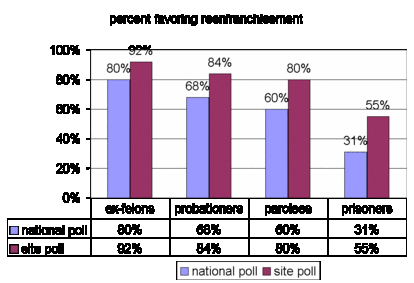A new Bureau of Justice Statistics report by Christopher Mumola discusses suicide and homicide in jail and prison. As summarized in the chart and table (click chart), there has been a steep drop in both types of death for both types of inmates. Remembering the old Kitsuse and Cicourel Social Problems article that I force-feed every grad student (1963’s “A Note on the Uses of Official Statistics”), I thought that perhaps officials had changed reporting practices or the way they classified causes of death. Yet deaths by all causes are under 3,000 annually in prisons and under 1,000 in jails. More precisely, 3,924 died in 2002 in an incarcerated population of 2,085,620 — less than two-tenths of one percent per year (.00188). Mortality rates for all causes have also declined precipitously for jails since 1980 and stabilized after a mid-1990s peak in prisons. So, I suspect there are real declines here, rather than simple changes in recordkeeping.
 Who dies in prison? Suicides tend to be white, male, and very young or older inmates. Homicide victims tend to be white or Hispanic males. Perhaps the most intriguing finding is that homicide rates are significantly lower in prison and jail than among the general population. When Mumola standardizes the rates to match the age, race, and gender composition of inmates, the pattern is even stronger: “the resident population had a homicide rate (35 per 100,000) nearly 9 times the rate of homicide in State prisons (4) and nearly 11 times higher than the rate in jails (3).
Who dies in prison? Suicides tend to be white, male, and very young or older inmates. Homicide victims tend to be white or Hispanic males. Perhaps the most intriguing finding is that homicide rates are significantly lower in prison and jail than among the general population. When Mumola standardizes the rates to match the age, race, and gender composition of inmates, the pattern is even stronger: “the resident population had a homicide rate (35 per 100,000) nearly 9 times the rate of homicide in State prisons (4) and nearly 11 times higher than the rate in jails (3).
I’m still trying to get my head around this paradoxical finding. Are we really less likely to be murdered in prison than on the street? Here are four hypotheses, and four “yeah buts.” (1) Is it a stark indictment of our ultraviolent society? Yeah, but violence has been trending downward since the early 1990s, and the 2002 homicide rate is identical to the 1966 rate; (2) Is it proof of the improved safety of our correctional facilities? Yeah, but prisons and jails clearly remain very dangerous and unhealthy places; (3) Is it evidence of the greater efficacy of the panopticon’s formal social control over the street’s informal controls? Yeah, but the streets upon which most of the general population walk are aready quite safe; (4) Is it a reflection of the not-so-great-as-one-might-think differences between the general population and the inmate population? Yeah, but a good portion of inmates have, after all, committed homicide and other violent crimes. My guess is that there’s some truth in each hypothesis, and in the labeling or reporting artifact explanation as well. Nevertheless, I find myself convinced that, to some extent, prisons and jails are becoming safer. I’ll have to adjust the hyperbole in my lecture about prisons being “crucibles of intimidation and violence” until I see evidence of deeper flaws in this analysis.



